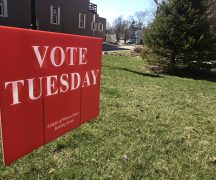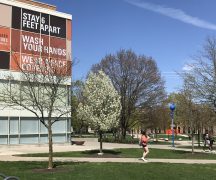It was an epidemic within a pandemic.
April 2020 was a time when the Covid-19 pandemic tightened a grip that still hasn’t really eased. It also marked the beginning of a year that would see 100,000 opioid deaths in the United States. That was the most since the U.S. Centers for Disease Control and Prevention started tracking them in 1999 and a 28% increase over a year earlier.
Put in context, the number is even more stunning. The number of opioid deaths in that year is more than 10% of all the 910,000 Americans killed by the pandemic so far.
April 2020 was also a time when federal stimulus checks went out to mitigate the economic harm caused by the calamity.
According to peer-reviewed research using Ohio Department of Health data and commissioned by Ohio Attorney General Dave Yost, the stimulus checks and other actions might have had at least one bad side effect.
“Policy responses to the pandemic have inadvertently resulted in contributing to the exacerbation of the epidemic,” the report said, later adding, “Although these government provided income assistance payments are intended to pay for basic needs, (they) may actually be facilitating a cyclic pattern of substance use and increased overdose deaths.”
The paper by members of Yost’s staff as well as the faculty at Bowling Green State University is being published in the International Journal of Drug Policy.
In a statement Thursday announcing the research, Yost highlighted the harm that the study said could have been caused by the stimulus payments — a phenomenon known among some academics as the “check effect.”
“The link between pandemic relief money and opioid overdose deaths is now evident,” he said in the statement. “The intent was to help Americans navigate this deadly pandemic but it also fueled a tidal wave of overdoses.”
However, that link isn’t a direct one, so it’s a little speculative. The study itself concluded only that the checks might have played a role in the spiking numbers of deaths.
“The identified change point may refer to the timing of many factors, not only the economic payments and further research is warranted to investigate the potential relationship between the COVID-19 economic impact payments and overdose deaths,” it said.
The pandemic led to a lot of stresses that could have hit those with addiction hard: isolation, unemployment, interrupted access to medicine and counseling — and the very real fear that you could get sick and die.
In an interview, Yost acknowledged the presence of other factors.
“The limitation on it is (the stimulus checks) aren’t a sole cause,” he said. “The paper said we were in the middle of a lockdown, there was massive fear and obviously we didn’t know what this pandemic was going to look like… In the middle of that, we have this money coming in and the science shows that it was a contributing causation, but not the sole causation.”
Another way to evaluate the impact of the checks on the overdose epidemic would be to look at overdose data gathered since the stimulus checks stopped going out in late 2020. However, due to lags in the process, such numbers don’t seem to be available yet.
Yost said that in publicizing the study, he was not saying the stimulus payments were a bad idea. In fact, he said, they were vital at that juncture.
“I don’t know that anybody could say it was a mistake” to send out the checks, he said. “First of all, we didn’t know (overdoses were going to spike) at the time. Secondly, the greater evil out there was the danger of a collapsing economy and people being displaced from their homes.
“There was a lot going on. So would you not send money? Would you not put that money out there in what was a universal crisis? I think that is a bit of a stretch.”
But going forward, Yost said, it’s important to examine consequences — intended and unintended — of sweeping decisions hurriedly made at the beginning of the crisis.
“Now that we do have this datapoint, our policymakers ought to be considering in the future as they design these programs, they ought to be asking ‘How can we do this in a way that would mitigate against what we know what happened?”
***
Also from Ohio Capital Journal:
Federal redistricting lawsuit filed as notice of impasse hits Ohio Supreme Court
The leader of an anti-abortion lobby and other Ohio citizens are suing the Ohio Redistricting Commission and the Secretary of State, accusing them of depriving them of rights under the U.S. Constitution.
Attorneys from the Columbus firm of Isaac Wiles & Burkholder, LLC, asked the U.S. District Court for the Southern District of Ohio to declare current legislative districts “or lack thereof” in violation of the U.S. Constitution, and to adopt the last plan the ORC approved. That plan, a revision of the first plan struck down by the Ohio Supreme Court, was also struck down by the high court.
Though not members of the lawsuit in their official capacities, several of the plaintiffs are leaders or staff at Ohio Right to Life, a lobby group who works on anti-abortion measures throughout the state.
Mike Gonidakis, president of Ohio Right to Life, is the lead plaintiff in the case, along with Mary Parker, OR2L’s director of legislative affairs. Also listed in the lawsuit is Margaret Conditt, who is on the lobby’s website as a “member trustee.”
Beth Vanderkooi, another plaintiff in the case, is the executive director of Greater Columbus Right to Life, and Ducia Hamm was previously listed as associate director of affiliate services for Heartbeat International, and religious anti-abortion organization.
After declaring two rounds of previous maps unconstitutional gerrymanders, the state supreme court sent the commission back to work with a Feb. 17 deadline, which the ORC passed by without adopting new maps.
Ohio’s state legislative districts are not “substantially similar in population,” according to the lawsuit.
With Thursday’s “impasse” of the Ohio Redistricting Commission members, the plaintiffs in the lawsuit say they “are cut out of the political process.”
“Either the 2010 legislative districts apply and their votes are diluted by the population growth reflected in the 2020 U.S. Census data,” the lawsuit stated. “Or alternatively, they are not members of any state legislative district and cannot vote for state house of representatives or senate candidates.”
The commission filed their notice of impasse on Friday, laying out the commission’s actions and non-actions from Feb. 7, when the supreme court invalidated the ORC revised General Assembly plan, until Thursday, when no map was approved.
“Among other discussion, (Senate) President (Matt) Huffman stated that the commission was at an impasse, as the commission is unable to ascertain and determine a plan that complies with the court’s order and the Ohio Constitution,” the notice, written by the Ohio Attorney General’s Office, informed the supreme court.
The lawsuit cites the 2020 census, which showed a net gain of more than 250,000 Ohioans over the last 10 years.
Because “valid redistricting” has yet to occur, the plaintiffs say they can’t decide on candidates to support, make a decision to run for office or “educate themselves or others on the positions of candidates in their districts and prepare to hold those candidates responsible.”
Gonidakis and the other Ohioans acknowledged that a nearly five-month legal battle on legislative redistricting is unlikely to have a resolution before the voter registration deadline of April 4 for the May primary, which is why they requested the use of a previous map for the primary.
The parties in the lawsuit said they chose the previously submitted maps, maps adopted without bipartisan support and called unconstitutional by the supreme court, because they “properly distribute voting power and are based on 2020 census data.”
They worry if elections were allowed to take place before the redistricting process is resulted, overpopulated districts could see vote dilution, and thus a “deprivation of political power and resources.”
A lack of districts deprives Ohioans of the right to vote, in violation of the U.S. Constitution and fundamental rights of Americans, the lawsuit states.
“There is no harm in the Redistricting Commission following the U.S. Constitution and plaintiffs receiving the right to vote,” according to the lawsuit.
The court challengers ask that a three-judge panel be assigned to the case to keep the ORC and the Secretary of State from “acting on their behalf” and implementing, enforcing or conducting elections under the current state of redistricting.
The lawsuit also asks the court to establish a schedule “to adopt a timely enacted and lawful plan and implement the new plan for Ohio’s state legislative districts.”
The lawsuit does not allege racial gerrymandering or any vote dilution based on racial discrimination, which the U.S. Supreme Court has set as a standard for taking any redistricting cases.
Senate President Matt Huffman, a member of the Ohio Redistricting Commission, accused Democrats of drawing maps to favor Dems while using racial gerrymandering. The Dems were the only ones to propose a map at Thursday’s meeting of the commission, and it was voted down along party lines after a lengthy dissection, mainly by Huffman.
This is the second federal lawsuit to be filed regarding redistricting in Ohio. In December, a pair of Mahoning County residents sued accusing the ORC of discriminating against Black voters in legislative and congressional district lines.
That lawsuit was put on hold after district lines were invalidated, and is still awaiting court decisions on maps before proceeding.





